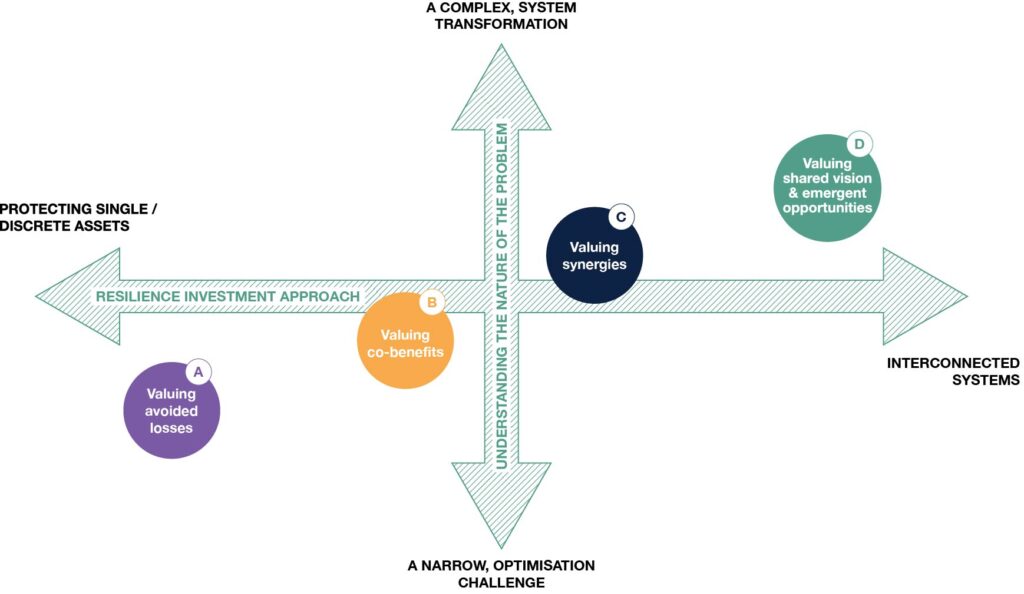Concept Paper: A Pathway Towards Systemic Resilience Investment
- Home
- Conceptpaper
Addressing climate resilience as a complex, systemic challenge requires moving beyond short-term fixes to adopt long-term, sustainable solutions. This concept paper advocates for a systems approach to resilience investment, guiding organisations through the ABCD framework. This framework helps organisations evolve from a narrow focus on individual assets to a comprehensive vision that aligns with broader resilience and economic goals. By fostering collaboration, flexible governance, and systems thinking, decision-makers can build a stronger case for resilience investments, ultimately increasing the flow of resources to projects that protect and empower vulnerable communities.
Through our research and case studies, the challenge of applying systems thinking to resilience investment emerged as a significant obstacle. Building capability for a systems approach to resilience investment represents a shift in mindset, from a reactive approach to a proactive one that anticipates and prepares for future challenges in a context of cascading and compounding climate impacts across systems. This concept paper introduces a framework that helps decision-makers develop the conceptual framing to build a strong case for resilience investment in this context. Using a staged ‘ABCD’ approach, it guides organisations through four stages, from focusing on individual assets to adopting a broader, systemic perspective that aligns decisions with a vision for a place.
Traditional business practices are rooted in a “business as usual” mindset, which tends to focus on short-term gains, risk mitigation at the level of individual assets, and efficiencies within existing systems. This mindset is not well-suited to thinking systemically, as it often overlooks the complex interdependencies and long-term implications of decisions, and in doing miss opportunities for a strong business case for resilience investment.
To help overcome this mindset challenge, we have developed an ABCD pathway that helps organisations to move beyond traditional approaches that are ill-equipped to address the multifaceted challenges of climate resilience investment. The stages of the pathway help to guide organisations from a narrow, asset-focused mindset to a broader, more systemic perspective on resilience. This pathway is important because it helps decision-makers gradually shift their thinking and strategies from simply protecting individual assets to considering the interconnectedness of entire systems—be it communities, economies, or ecosystems. As you move through the stages, the focus expands from avoiding losses at a single point to unlocking synergies, co-benefits, and emergent opportunities that benefit a broader set of stakeholders. This step-by-step progression allows for a manageable transition, helping organisations to build their capacity for systemic thinking and action over time.

In this stage, resilience investment decisions focus on a single asset, supplementing traditional cost-benefit analysis with considerations of future climate risks and potential avoided losses. This approach strengthens the business case for resilience by highlighting how protecting an asset from future disasters can save money in the long run. Outputs include risk assessments that incorporate future climate risks and investment cases that weigh the costs of action against the benefits of avoided losses
Stage B expands the focus by incorporating indirect and intangible co-benefits into the assessment of a single asset. Beyond just avoiding losses, this stage considers the broader social, environmental, governance, and economic impacts of resilience investments. By integrating these wider factors into risk assessments and cost-benefit analyses, decision-makers can better justify and prioritise investments that offer multiple benefits to communities, businesses, and the environment.
In Stage C, the focus shifts from a single asset to the interrelationships within and across systems. This approach encourages collaboration among various stakeholders, recognising the complex and cascading nature of climate risks. By identifying strategic synergies and stacking benefits, organisations can maximise the impact of resilience investments. Partnerships and cross-sectoral collaboration become key to scaling up efforts, enhancing adaptive capacity, and driving innovation.
Stage D represents the most systemic approach, where resilience investments are guided by a long-term, transformational vision. Organisations embrace prototyping, learning, and refinement, recognising that progress may be non-linear. This stage focuses on the combined value of multiple initiatives, creating momentum toward a shared vision. Governance structures and cross-sectoral collaborations are essential for unlocking opportunities and ensuring that investments create value across systems and scales, from households to regional levels.
Find out more about the ABCD stages for systemic resilience investment by downloading the Concept Paper or watching the presentation.
Making the case for resilience investment, presented at the Australian Disaster Resilience Conference September 2024:
